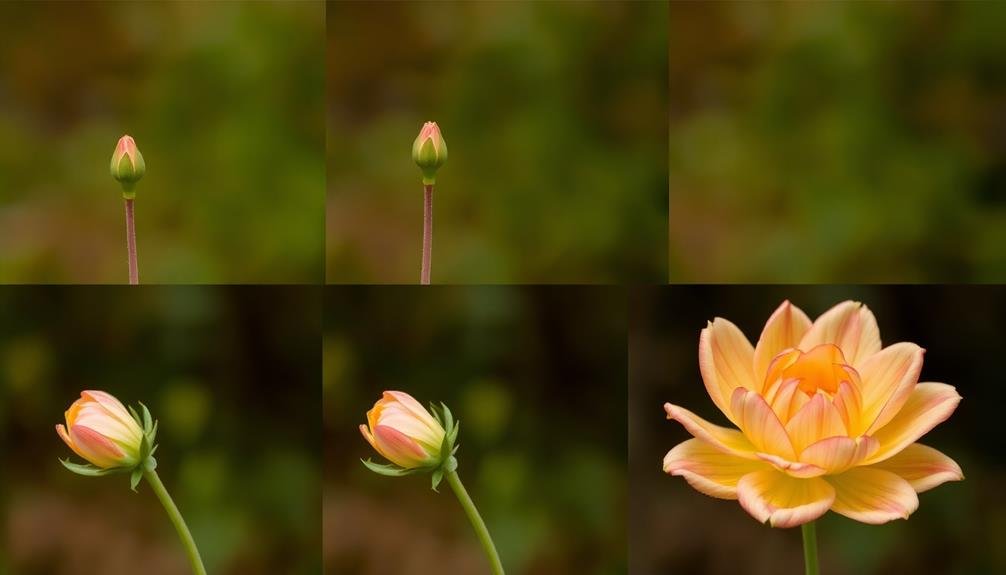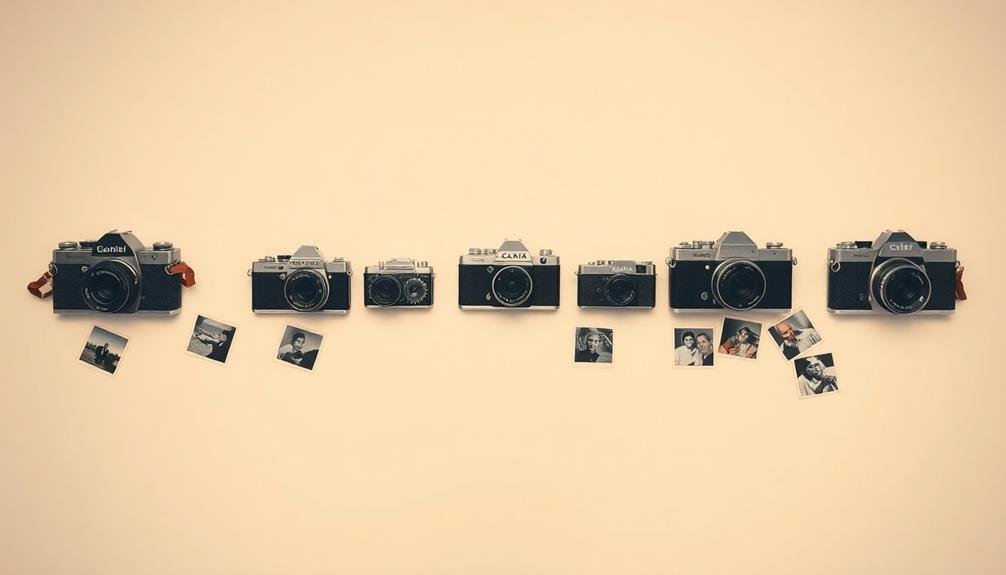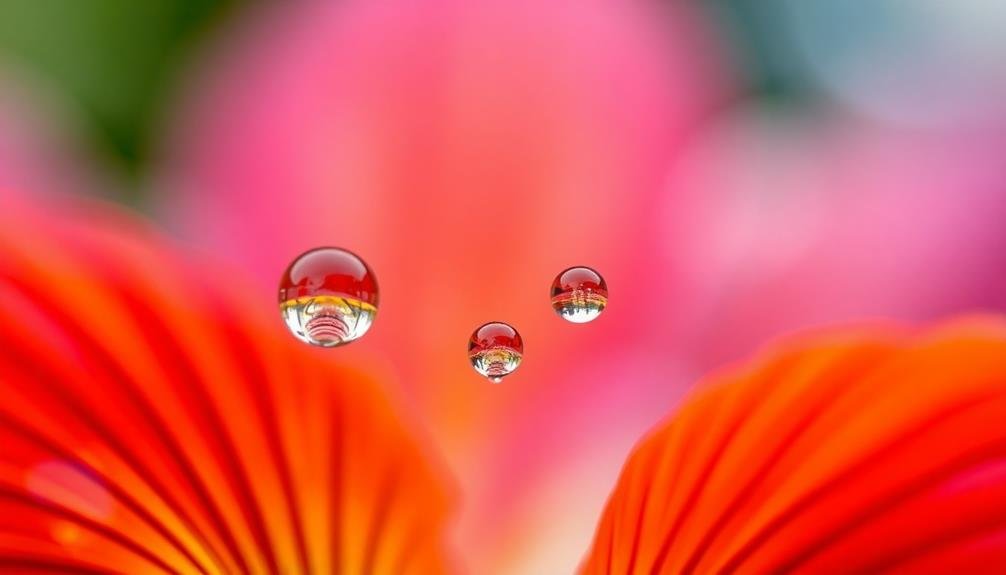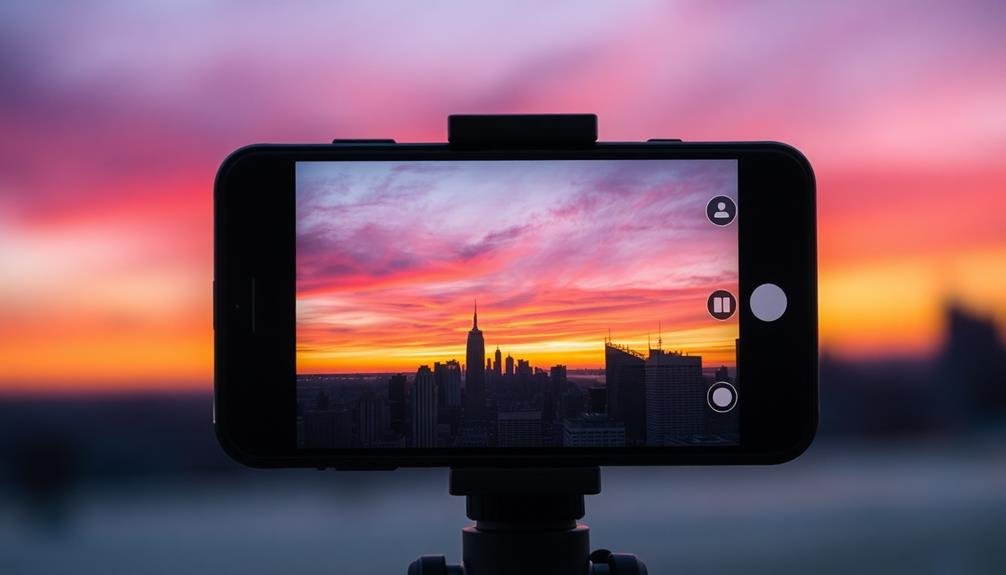To create a compelling photo series, you'll need to define a clear narrative arc and choose a consistent visual style. Capture varied perspectives and angles to keep viewers engaged, and utilize thoughtful sequencing for maximum impact. Incorporate emotional elements to connect with your audience, and leverage smartphone camera features to enhance your shots. Edit your images for cohesion and flow, experimenting with composition techniques to add depth and interest. Finally, share your series effectively on appropriate platforms. By mastering these elements, you'll craft a visual story that resonates long after the last image. Dive deeper to reveal the full potential of your photographic storytelling.
Define Your Narrative Arc

Three key elements form the foundation of a compelling photo series: a clear narrative, visual cohesion, and emotional impact.
To create a fascinating story through your images, you'll need to define your narrative arc first. Start by identifying the main theme or message you want to convey. This could be a personal journey, a social issue, or an exploration of a specific subject.
Next, outline the progression of your story. Consider how you'll introduce your topic, develop it, and conclude it. Think about the key moments or turning points that will drive your narrative forward. Each image should serve a purpose in advancing the story or revealing new aspects of your subject.
As you plan your series, consider the emotions you want to evoke in your viewers. Will you take them on a journey from despair to hope, or challenge their perceptions?
Map out how these emotions will evolve throughout your series. Remember, a strong narrative arc will guide your viewers through your story, keeping them engaged and invested in the visual journey you've created.
Choose a Consistent Visual Style

Visual consistency is essential when creating a compelling photo series. It helps tie your images together and reinforces your narrative arc. To achieve this, you'll need to make deliberate choices about your photographic style and stick to them throughout the series.
Start by deciding on a color palette. Will you use vibrant, saturated colors or opt for muted tones? Consider whether black and white might better serve your story.
Next, choose a consistent lighting style. Harsh shadows or soft, diffused light can dramatically alter the mood of your images. Think about your composition techniques, such as the rule of thirds or leading lines, and apply them consistently.
Your choice of lenses and focal lengths will also impact the visual style. Wide-angle lenses create a sense of space, while telephoto lenses compress perspective. Decide on a depth of field strategy – will you use shallow focus to isolate subjects or keep everything sharp?
Finally, consider your post-processing approach. Develop a consistent editing style that enhances your chosen look without overpowering the narrative.
Capture Varied Perspectives and Angles

To create visual interest in your photo series, experiment with a mix of wide and close-up shots.
You'll captivate viewers by seeking out unexpected vantage points, like shooting from ground level or an elevated position.
Don't forget to play with different focal lengths, as this can dramatically alter the mood and impact of your images.
Wide vs. Close-up Shots
Photographers must master the art of balancing wide and close-up shots to create a compelling photo series. Wide shots provide context, setting the scene and giving viewers a sense of place. They're essential for establishing the overall environment and showing relationships between subjects. Use wide shots to capture landscapes, cityscapes, or group scenes that tell a broader story.
Close-up shots, on the other hand, draw attention to specific details and emotions. They're perfect for highlighting facial expressions, textures, or intricate objects that might be overlooked in wider frames. Close-ups create intimacy and allow viewers to connect more deeply with your subjects.
To create a dynamic series, alternate between wide and close-up shots. Start with a wide shot to introduce the setting, then zoom in on key details.
Return to wider perspectives to show how these details fit into the larger picture. This back-and-forth approach keeps viewers engaged and helps them understand the story from multiple angles.
Unexpected Vantage Points
Elevate your photo series by embracing unexpected vantage points. Challenge yourself to capture scenes from angles that viewers mightn't typically experience. This approach adds intrigue and depth to your narrative, compelling your audience to engage more deeply with your work.
Experiment with various perspectives:
- Shoot from ground level, capturing the world from a child's or animal's point of view
- Climb to high vantage points, offering a bird's-eye view of your subject
- Get uncomfortably close, revealing intricate details often overlooked
By varying your shooting position, you'll create visual interest and encourage viewers to see familiar subjects in new ways. Don't be afraid to lie on the ground, climb trees, or use tools like drones or selfie sticks to achieve unique angles.
Remember, the goal is to present your subject matter from perspectives that challenge conventional viewpoints.
Unexpected vantage points can also help emphasize certain elements of your story or convey specific emotions. A low angle might make a subject appear more powerful, while an overhead shot could create a sense of vulnerability.
Play With Focal Lengths
A lens's focal length is a powerful tool in your photographic arsenal. By experimenting with different focal lengths, you can dramatically alter the viewer's perception of your subject and create a more dynamic photo series.
Wide-angle lenses allow you to capture expansive scenes, emphasizing the relationship between foreground and background elements. They're ideal for landscape shots or cramped interior spaces, giving a sense of vastness or intimacy.
On the other hand, telephoto lenses compress perspective, bringing distant subjects closer and creating a flattened effect. This compression can be used to isolate subjects from their surroundings or to stack multiple elements in a visually striking way.
Medium focal lengths, like 50mm, provide a natural perspective similar to human vision, making them versatile for various subjects.
Utilize Sequencing for Impact

When you're creating a photo series, thoughtful sequencing can elevate your work from good to outstanding.
You'll build narrative momentum by carefully arranging images to tell a compelling story, while creating visual rhythms that keep viewers engaged.
Build Narrative Momentum
Building narrative momentum is essential for creating a compelling photo series. As you progress through your images, aim to heighten interest and emotional investment. Start with a strong opening image that captures attention, then gradually reveal more information and complexity. Each subsequent photo should build upon the previous ones, adding layers to the story and deepening the viewer's understanding.
To create narrative momentum, consider:
- Introducing new characters or elements
- Revealing unexpected twists or developments
- Increasing the visual or emotional intensity
Use pacing to your advantage. Alternate between slower, contemplative moments and more dynamic, action-packed scenes. This rhythm keeps viewers engaged and helps control the emotional flow of your series.
Don't reveal everything at once; leave some mystery to maintain intrigue.
As you approach the climax of your photo series, intensify the visual and emotional impact. This could involve more dramatic compositions, bolder colors, or more powerful subject matter.
Create Visual Rhythms
Creating visual rhythms through strategic sequencing amplifies the impact of your photo series. As you arrange your images, consider how they flow together visually and thematically. Look for patterns in color, composition, or subject matter that can create a sense of rhythm when viewed in sequence.
Start with a strong opening image that sets the tone for your series. Then, alternate between wide and close-up shots to provide visual variety and maintain viewer interest. Use repetition of certain elements or themes to create a cohesive narrative thread throughout the series.
Don't be afraid to experiment with contrasting images to create tension or highlight differences. This can add depth and complexity to your story. Pay attention to the pacing of your series, building momentum towards key moments or revelations.
Consider using diptychs or triptychs to create mini-narratives within your larger series. These groupings can emphasize connections between images and add layers of meaning to your story.
Guide Viewer's Eye
The art of guiding the viewer's eye through a photo series lies in strategic sequencing. By carefully arranging your images, you're creating a visual journey that leads your audience through your story.
Start with a powerful opening image that captivates and sets the tone. Then, build momentum by alternating between wide and close-up shots, revealing details and context as you progress.
Consider the emotional impact of each shift. You can create tension by juxtaposing contrasting images or build harmony through visual echoes. Use pacing to control the rhythm of your narrative, slowing down for key moments and speeding up to convey action or passage of time.
To guide the viewer's eye effectively:
- Place your subject off-center using the rule of thirds
- Use leading lines to draw attention to focal points
- Create depth with foreground, middle ground, and background elements
End your series with a strong closing image that leaves a lasting impression or invites reflection.
Incorporate Emotional Elements

Emotional elements breathe life into your photo series, transforming it from a mere collection of images into a powerful narrative. To incorporate these elements effectively, focus on capturing genuine human expressions, interactions, and moments of vulnerability.
Look for scenes that evoke empathy, joy, sorrow, or any other strong emotion in your viewers. Consider the use of color, lighting, and composition to enhance the emotional impact of your images. Warm tones can convey comfort and intimacy, while cool tones might suggest isolation or melancholy.
Dramatic lighting can heighten tension or create a sense of mystery. Pay attention to body language and facial expressions, as these are powerful conveyors of emotion.
Don't shy away from controversial or difficult subjects. Often, the most compelling photo series tackle challenging themes that resonate deeply with viewers. However, approach these topics with sensitivity and respect.
Include contextual elements that help tell the story and provide emotional depth. Props, environmental details, and symbolic objects can all contribute to the emotional narrative of your series.
Leverage Smartphone Camera Features

Modern smartphones offer a multitude of advanced camera features that can greatly enhance your photo series. Take advantage of these tools to capture more compelling images and tell a stronger visual story.
Start by mastering your phone's portrait mode, which creates a shallow depth of field, isolating your subject and adding a professional look to your photos.
Experiment with your device's night mode capabilities to capture stunning low-light scenes without the need for additional equipment. This feature allows you to extend your shooting hours and add atmospheric elements to your series.
Don't overlook your phone's panorama function, which can help you capture sweeping landscapes or large group shots, adding variety to your visual narrative.
To create imagery in your audience's mind, consider these smartphone photography techniques:
- Use burst mode to capture fleeting moments and expressions
- Employ HDR for high-contrast scenes to balance light and shadow
- Utilize time-lapse or slow-motion video to add dynamic elements
Edit for Cohesion and Flow

Once you've captured your series of compelling images, it's time to edit them for cohesion and flow. Start by selecting your strongest images that best convey your story's narrative. Aim for a balanced mix of wide, medium, and close-up shots to provide visual variety and maintain viewer interest.
Arrange your photos in a logical sequence that guides viewers through your story. Consider using a chronological order or grouping images by themes or locations. Pay attention to visual connections between images, ensuring colors, shapes, or subjects flow naturally from one photo to the next.
Maintain a consistent editing style across all images to create a unified look. Adjust exposure, contrast, and color balance to achieve a cohesive aesthetic. However, be careful not to over-edit, as this can detract from the authenticity of your story.
Trim your selection ruthlessly, removing any redundant or weak images that don't contribute to the overall narrative. Remember, less is often more in storytelling.
Experiment With Composition Techniques

Throughout your photo series, it's crucial to experiment with various composition techniques to create visually arresting images. By varying your approach, you'll add depth and interest to your storytelling.
Try incorporating the rule of thirds, leading lines, and framing to guide viewers' eyes through each photograph and the series as a whole.
Don't be afraid to push boundaries and break traditional rules. Experiment with unusual angles, extreme close-ups, or wide-angle shots to offer fresh perspectives.
You can also play with negative space, symmetry, or asymmetry to evoke different emotions and emphasize key elements in your narrative.
Consider these composition techniques to enhance your photo series:
- Use repetition of shapes, colors, or subjects to create a cohesive visual theme
- Incorporate contrast through light and shadow, color, or scale to add drama
- Employ layering to add depth and complexity to your images
Share Your Series Effectively

The final step in creating a compelling photo series is sharing it effectively with your audience. Choose the right platform for your work, considering your target viewers and the series' theme. Social media platforms like Instagram can be great for visual storytelling, while dedicated photography websites might be better for more serious or extensive projects.
Present your series in a logical order that enhances the narrative. This could be chronological, thematic, or based on visual elements like color or composition. Use consistent editing across all images to maintain a cohesive look. Consider including short captions or titles to provide context and guide viewers through the story.
When displaying your series, pay attention to the spacing and layout. Whether online or in print, guarantee there's enough breathing room between images. If exhibiting in a physical space, think about the flow of the room and how viewers will move through your series.
Lastly, be open to feedback and engage with your audience. Their reactions and interpretations can offer valuable insights and potentially inspire future projects.
Frequently Asked Questions
How Many Photos Should Be Included in a Compelling Photo Series?
There's no fixed number for a compelling photo series. You'll want to include enough images to tell your story effectively, but not so many that you overwhelm viewers. Typically, 5-15 photos work well for most series.
Can I Mix Color and Black-And-White Images in a Series?
Yes, you can mix color and black-and-white images in a series. It's an effective way to create contrast and emphasize certain elements. You'll want to guarantee the mix serves your narrative and doesn't feel random or jarring.
What Software Is Best for Editing a Photo Series?
You'll find Adobe Lightroom and Capture One are top choices for editing photo series. They offer powerful tools for batch processing, color grading, and consistency. For more advanced editing, you can't go wrong with Adobe Photoshop.
How Do I Handle Model Releases for a Public Photo Series?
You'll need to obtain signed model releases from anyone identifiable in your public photo series. It's essential to protect yourself legally and respect your subjects' rights. Always have releases ready before shooting and explain their importance.
Are There Legal Considerations When Photographing in Public Spaces for a Series?
You'll need to be aware of local laws regarding public photography. While generally legal, you can't invade privacy or trespass. Be cautious with commercial use, and respect individuals' rights to not be photographed.
In Summary
You've now got the tools to create a compelling photo series. Remember, it's all about telling a story through your lens. Don't be afraid to experiment and push your boundaries. With practice, you'll develop your unique style and narrative voice. Whether you're using a smartphone or professional camera, these techniques will help you craft photo series that captivate and resonate with your audience. Now go out and start shooting your story!





Leave a Reply